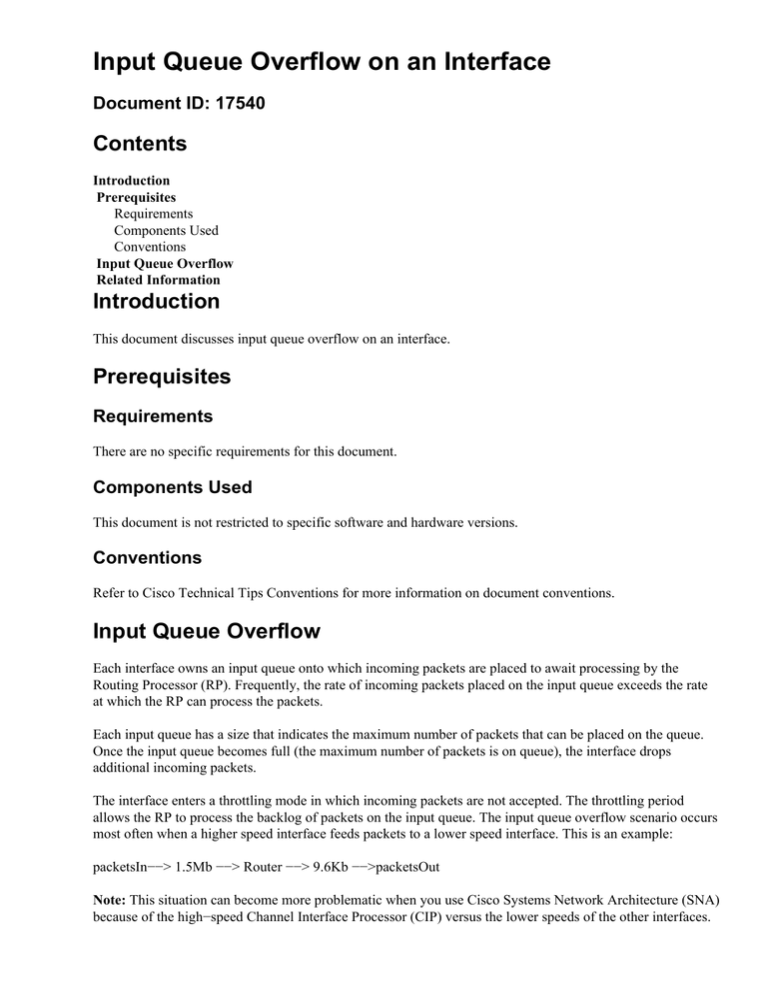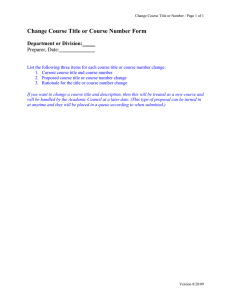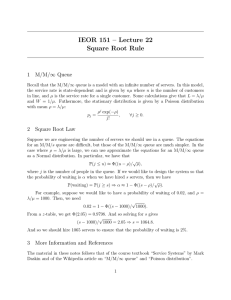
Input Queue Overflow on an Interface
Document ID: 17540
Contents
Introduction
Prerequisites
Requirements
Components Used
Conventions
Input Queue Overflow
Related Information
Introduction
This document discusses input queue overflow on an interface.
Prerequisites
Requirements
There are no specific requirements for this document.
Components Used
This document is not restricted to specific software and hardware versions.
Conventions
Refer to Cisco Technical Tips Conventions for more information on document conventions.
Input Queue Overflow
Each interface owns an input queue onto which incoming packets are placed to await processing by the
Routing Processor (RP). Frequently, the rate of incoming packets placed on the input queue exceeds the rate
at which the RP can process the packets.
Each input queue has a size that indicates the maximum number of packets that can be placed on the queue.
Once the input queue becomes full (the maximum number of packets is on queue), the interface drops
additional incoming packets.
The interface enters a throttling mode in which incoming packets are not accepted. The throttling period
allows the RP to process the backlog of packets on the input queue. The input queue overflow scenario occurs
most often when a higher speed interface feeds packets to a lower speed interface. This is an example:
packetsIn−−> 1.5Mb −−> Router −−> 9.6Kb −−>packetsOut
Note: This situation can become more problematic when you use Cisco Systems Network Architecture (SNA)
because of the high−speed Channel Interface Processor (CIP) versus the lower speeds of the other interfaces.
This show interface interface−identifier output shows the current output queue levels and the number of
outgoing packets dropped:
dspu−7k#show interface channel 4/2
Channel4/2 is up, line protocol is up
Hardware is cxBus IBM Channel
MTU 4472 bytes, BW 98304 Kbit, DLY 100 usec, rely 255/255, load 1/255
Encapsulation CHANNEL, loopback not set, keepalive not set
Virtual interface
Last input 0:00:04, output 0:00:04, output hang never
Last clearing of "show interface" counters never
Output queue 0/40, 0 drops; input queue 63/75, 118 drops
5 minute input rate 0 bits/sec, 0 packets/sec
5 minute output rate 0 bits/sec, 0 packets/sec
101646 packets input, 2427760 bytes, 0 no buffer
Received 0 broadcasts, 0 runts, 0 giants
0 input errors, 0 CRC, 0 frame, 0 overrun, 0 ignored, 0 abort
210328 packets output, 5016959 bytes, 0 underruns
0 output errors, 0 collisions, 0 interface resets, 0 restarts
0 output buffer failures, 0 output buffers swapped out
The show interface interface−identifier provides this information:
• The input queue x/y counter shows the current number of packets on the input queue x and the
current size of the input queue y.
• The drops counter indicates the number of incoming packets dropped.
• If the current number of packets on the input queue is consistently at or greater than 80 percent of the
current size of the input queue, the size of the input queue might require tuning in order to
accommodate the incoming packet rate.
• Even if the current number of packets on the input queue never seems to approach the size of the
input queue, bursts of packets might still be overflowing the queue.
• If the drops counter increases at a high rate, the size of the input queue can require tuning in order to
accommodate the bursts.
Note: You can tune the size of the input queue using the hold−queue interface configuration command, as
this example shows.
interface channel 4/2
hold−queue 125 in
Related Information
• Troubleshooting Switch Port and Interface Problems
• Technical Support & Documentation − Cisco Systems
Contacts & Feedback | Help | Site Map
© 2014 − 2015 Cisco Systems, Inc. All rights reserved. Terms & Conditions | Privacy Statement | Cookie Policy | Trademarks of
Cisco Systems, Inc.
Updated: Jul 19, 2006
Document ID: 17540




